Organizational Behaviour: Motivation, Team Building, Leadership at M&S
VerifiedAdded on 2021/01/01
|12
|3493
|339
Report
AI Summary
This report provides a comprehensive overview of organizational behaviour, focusing on three key areas: motivation, team building and development, and leadership. The report defines each topic, presenting two relevant theories for each, such as Maslow's Hierarchy of Needs and Adam's Equity Theory for motivation, Tuckman's Stages of team building, and Situational Leadership for leadership. The report then delves into how these theories are applied within Marks & Spencer (M&S), a leading retail company in the UK, highlighting the practical implications of situational leadership and Tuckman's stages of team building. The analysis demonstrates how M&S utilizes these theories to address challenges, improve employee performance, and achieve its organizational goals. The report concludes by summarizing the key findings and their significance for organizational success.
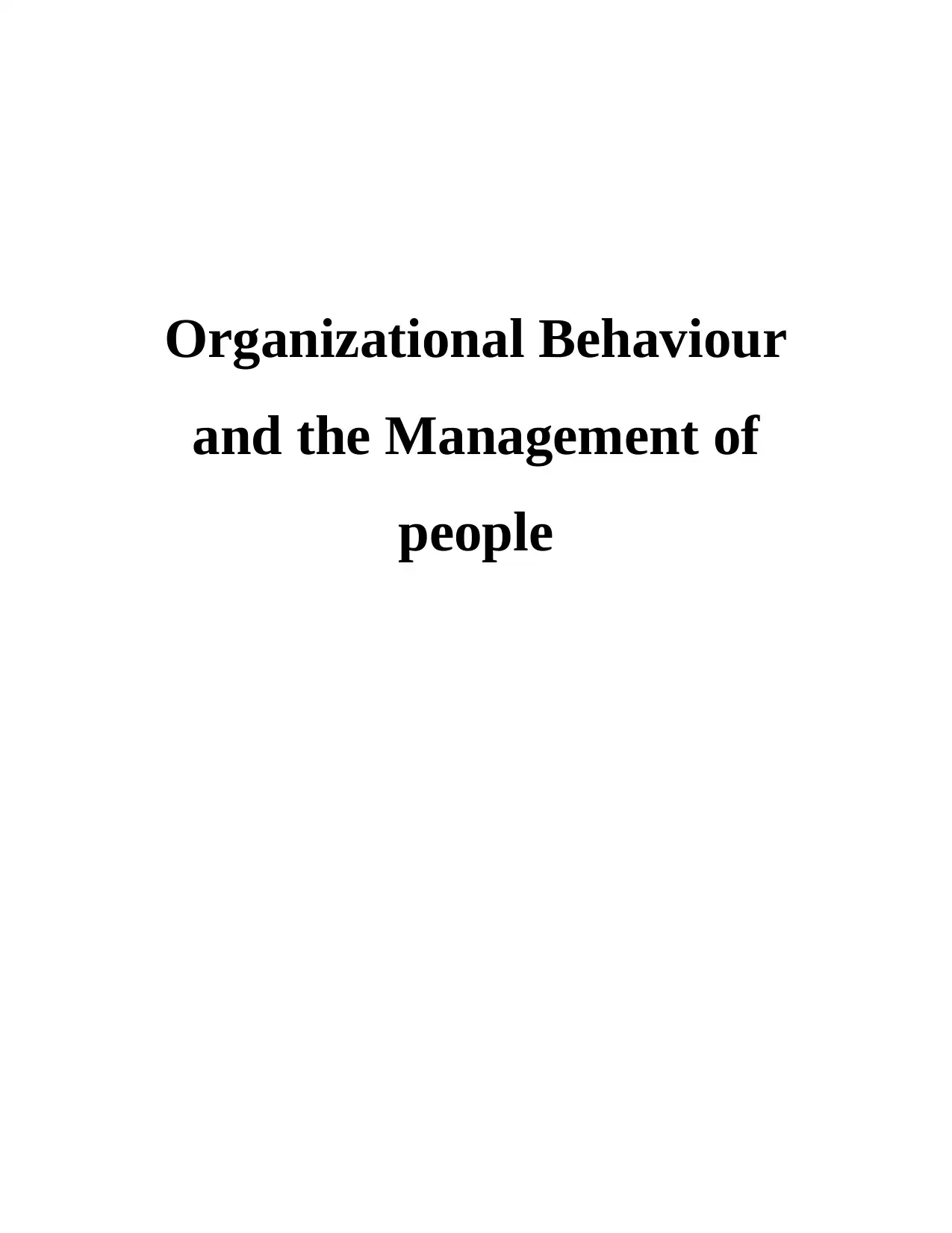
Organizational Behaviour
and the Management of
people
and the Management of
people
Paraphrase This Document
Need a fresh take? Get an instant paraphrase of this document with our AI Paraphraser
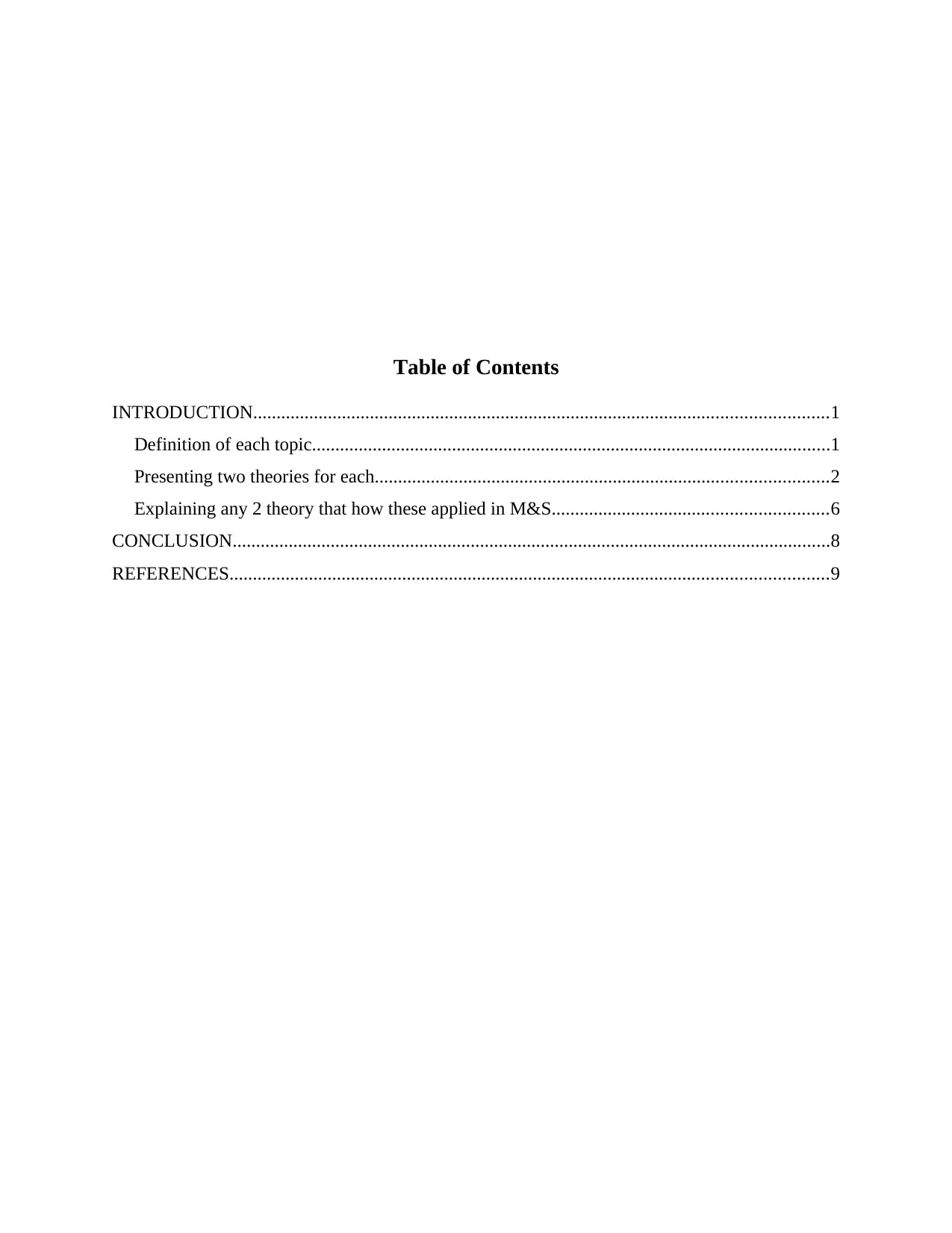
Table of Contents
INTRODUCTION...........................................................................................................................1
Definition of each topic...............................................................................................................1
Presenting two theories for each.................................................................................................2
Explaining any 2 theory that how these applied in M&S...........................................................6
CONCLUSION................................................................................................................................8
REFERENCES................................................................................................................................9
INTRODUCTION...........................................................................................................................1
Definition of each topic...............................................................................................................1
Presenting two theories for each.................................................................................................2
Explaining any 2 theory that how these applied in M&S...........................................................6
CONCLUSION................................................................................................................................8
REFERENCES................................................................................................................................9
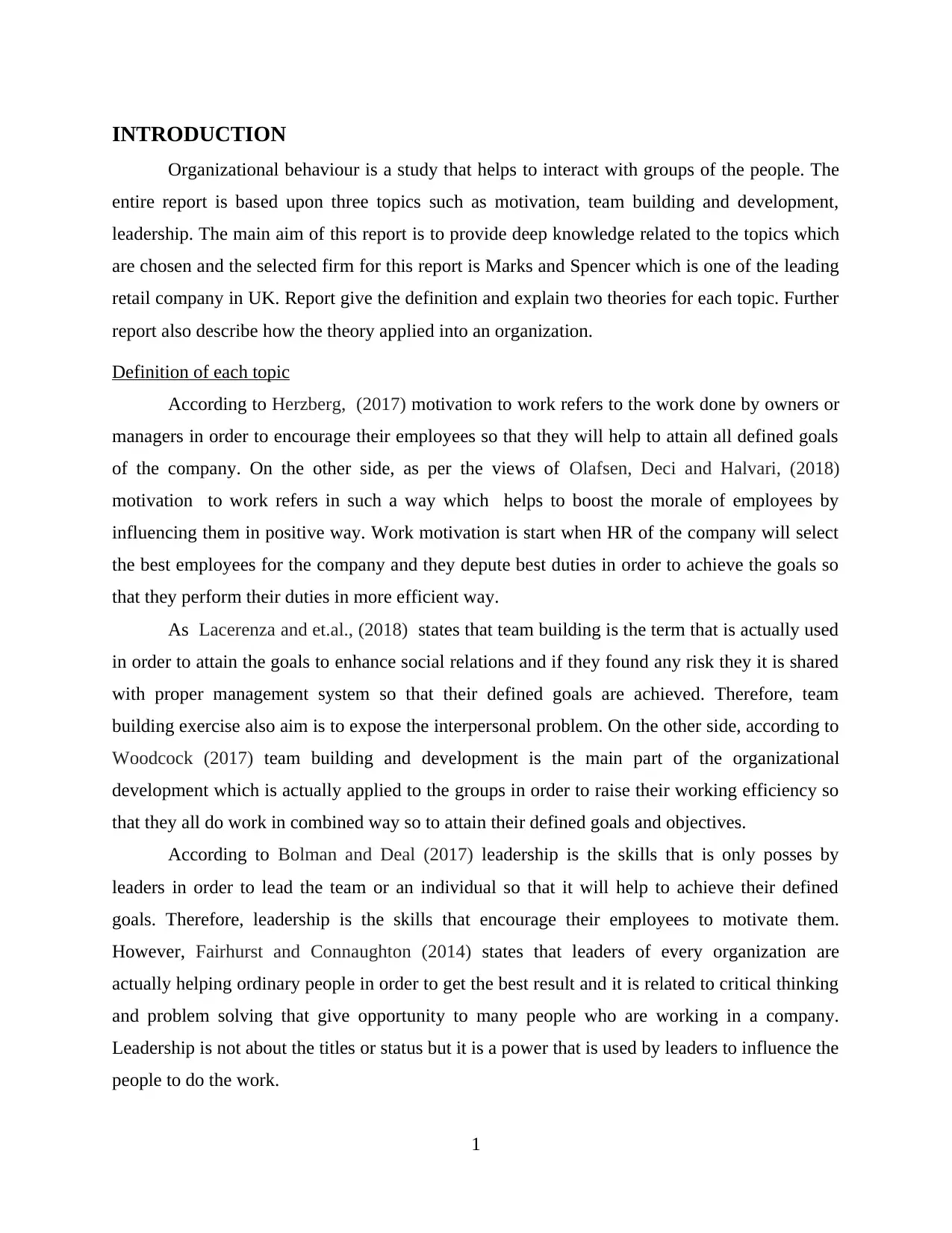
INTRODUCTION
Organizational behaviour is a study that helps to interact with groups of the people. The
entire report is based upon three topics such as motivation, team building and development,
leadership. The main aim of this report is to provide deep knowledge related to the topics which
are chosen and the selected firm for this report is Marks and Spencer which is one of the leading
retail company in UK. Report give the definition and explain two theories for each topic. Further
report also describe how the theory applied into an organization.
Definition of each topic
According to Herzberg, (2017) motivation to work refers to the work done by owners or
managers in order to encourage their employees so that they will help to attain all defined goals
of the company. On the other side, as per the views of Olafsen, Deci and Halvari, (2018)
motivation to work refers in such a way which helps to boost the morale of employees by
influencing them in positive way. Work motivation is start when HR of the company will select
the best employees for the company and they depute best duties in order to achieve the goals so
that they perform their duties in more efficient way.
As Lacerenza and et.al., (2018) states that team building is the term that is actually used
in order to attain the goals to enhance social relations and if they found any risk they it is shared
with proper management system so that their defined goals are achieved. Therefore, team
building exercise also aim is to expose the interpersonal problem. On the other side, according to
Woodcock (2017) team building and development is the main part of the organizational
development which is actually applied to the groups in order to raise their working efficiency so
that they all do work in combined way so to attain their defined goals and objectives.
According to Bolman and Deal (2017) leadership is the skills that is only posses by
leaders in order to lead the team or an individual so that it will help to achieve their defined
goals. Therefore, leadership is the skills that encourage their employees to motivate them.
However, Fairhurst and Connaughton (2014) states that leaders of every organization are
actually helping ordinary people in order to get the best result and it is related to critical thinking
and problem solving that give opportunity to many people who are working in a company.
Leadership is not about the titles or status but it is a power that is used by leaders to influence the
people to do the work.
1
Organizational behaviour is a study that helps to interact with groups of the people. The
entire report is based upon three topics such as motivation, team building and development,
leadership. The main aim of this report is to provide deep knowledge related to the topics which
are chosen and the selected firm for this report is Marks and Spencer which is one of the leading
retail company in UK. Report give the definition and explain two theories for each topic. Further
report also describe how the theory applied into an organization.
Definition of each topic
According to Herzberg, (2017) motivation to work refers to the work done by owners or
managers in order to encourage their employees so that they will help to attain all defined goals
of the company. On the other side, as per the views of Olafsen, Deci and Halvari, (2018)
motivation to work refers in such a way which helps to boost the morale of employees by
influencing them in positive way. Work motivation is start when HR of the company will select
the best employees for the company and they depute best duties in order to achieve the goals so
that they perform their duties in more efficient way.
As Lacerenza and et.al., (2018) states that team building is the term that is actually used
in order to attain the goals to enhance social relations and if they found any risk they it is shared
with proper management system so that their defined goals are achieved. Therefore, team
building exercise also aim is to expose the interpersonal problem. On the other side, according to
Woodcock (2017) team building and development is the main part of the organizational
development which is actually applied to the groups in order to raise their working efficiency so
that they all do work in combined way so to attain their defined goals and objectives.
According to Bolman and Deal (2017) leadership is the skills that is only posses by
leaders in order to lead the team or an individual so that it will help to achieve their defined
goals. Therefore, leadership is the skills that encourage their employees to motivate them.
However, Fairhurst and Connaughton (2014) states that leaders of every organization are
actually helping ordinary people in order to get the best result and it is related to critical thinking
and problem solving that give opportunity to many people who are working in a company.
Leadership is not about the titles or status but it is a power that is used by leaders to influence the
people to do the work.
1
⊘ This is a preview!⊘
Do you want full access?
Subscribe today to unlock all pages.

Trusted by 1+ million students worldwide
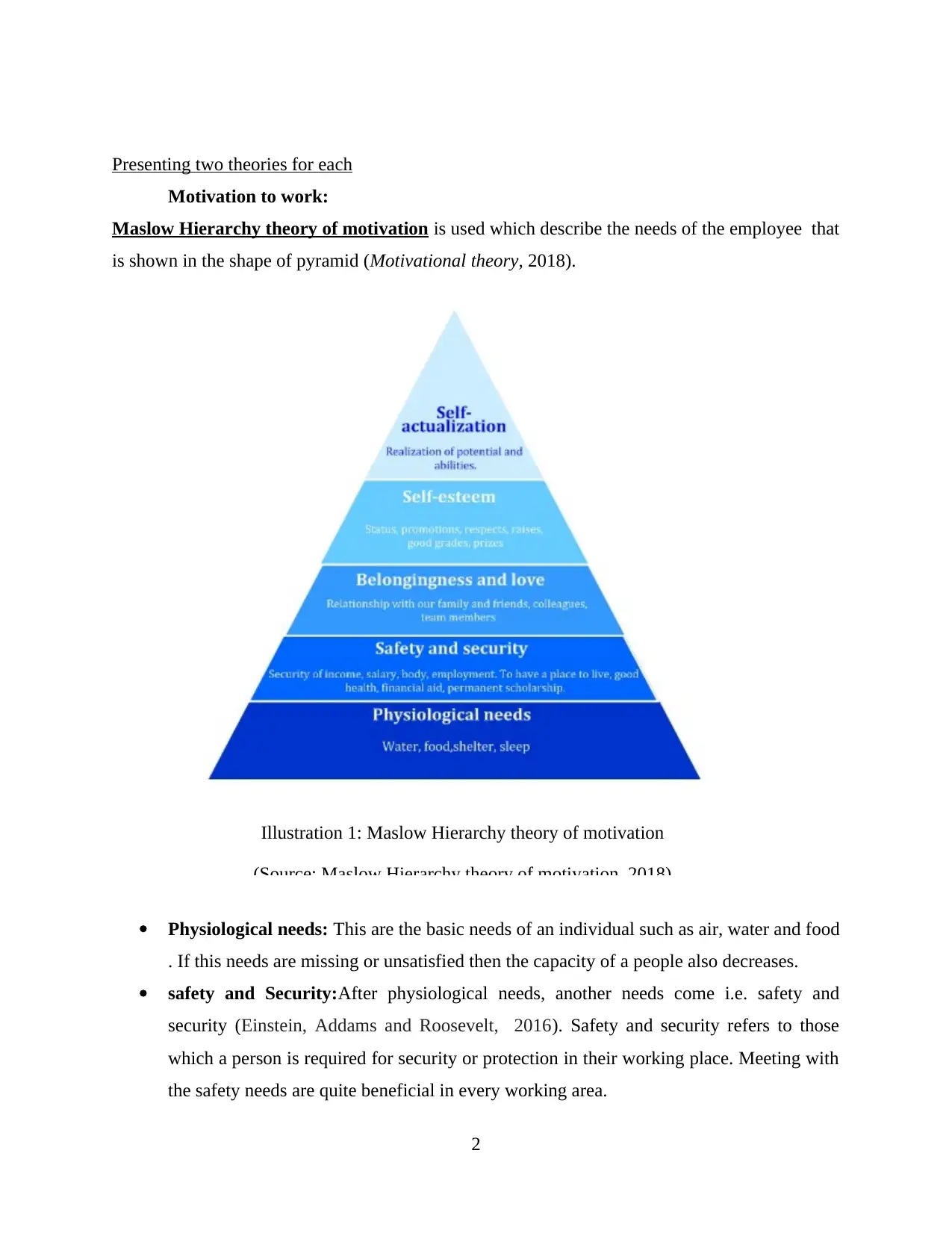
Presenting two theories for each
Motivation to work:
Maslow Hierarchy theory of motivation is used which describe the needs of the employee that
is shown in the shape of pyramid (Motivational theory, 2018).
Physiological needs: This are the basic needs of an individual such as air, water and food
. If this needs are missing or unsatisfied then the capacity of a people also decreases.
safety and Security:After physiological needs, another needs come i.e. safety and
security (Einstein, Addams and Roosevelt, 2016). Safety and security refers to those
which a person is required for security or protection in their working place. Meeting with
the safety needs are quite beneficial in every working area.
2
Illustration 1: Maslow Hierarchy theory of motivation
(Source: Maslow Hierarchy theory of motivation, 2018)
Motivation to work:
Maslow Hierarchy theory of motivation is used which describe the needs of the employee that
is shown in the shape of pyramid (Motivational theory, 2018).
Physiological needs: This are the basic needs of an individual such as air, water and food
. If this needs are missing or unsatisfied then the capacity of a people also decreases.
safety and Security:After physiological needs, another needs come i.e. safety and
security (Einstein, Addams and Roosevelt, 2016). Safety and security refers to those
which a person is required for security or protection in their working place. Meeting with
the safety needs are quite beneficial in every working area.
2
Illustration 1: Maslow Hierarchy theory of motivation
(Source: Maslow Hierarchy theory of motivation, 2018)
Paraphrase This Document
Need a fresh take? Get an instant paraphrase of this document with our AI Paraphraser
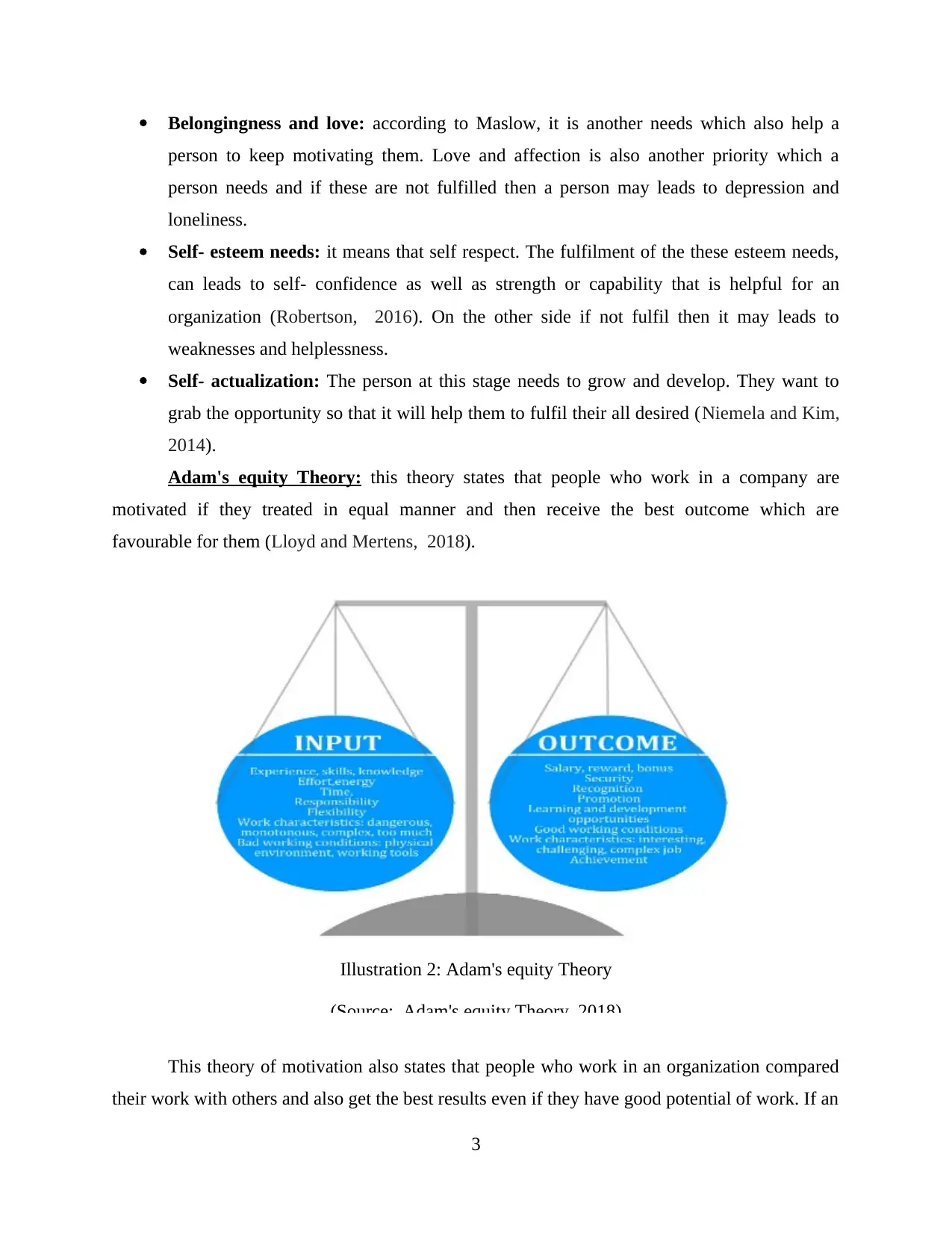
Belongingness and love: according to Maslow, it is another needs which also help a
person to keep motivating them. Love and affection is also another priority which a
person needs and if these are not fulfilled then a person may leads to depression and
loneliness.
Self- esteem needs: it means that self respect. The fulfilment of the these esteem needs,
can leads to self- confidence as well as strength or capability that is helpful for an
organization (Robertson, 2016). On the other side if not fulfil then it may leads to
weaknesses and helplessness.
Self- actualization: The person at this stage needs to grow and develop. They want to
grab the opportunity so that it will help them to fulfil their all desired (Niemela and Kim,
2014).
Adam's equity Theory: this theory states that people who work in a company are
motivated if they treated in equal manner and then receive the best outcome which are
favourable for them (Lloyd and Mertens, 2018).
This theory of motivation also states that people who work in an organization compared
their work with others and also get the best results even if they have good potential of work. If an
3
Illustration 2: Adam's equity Theory
(Source: Adam's equity Theory, 2018)
person to keep motivating them. Love and affection is also another priority which a
person needs and if these are not fulfilled then a person may leads to depression and
loneliness.
Self- esteem needs: it means that self respect. The fulfilment of the these esteem needs,
can leads to self- confidence as well as strength or capability that is helpful for an
organization (Robertson, 2016). On the other side if not fulfil then it may leads to
weaknesses and helplessness.
Self- actualization: The person at this stage needs to grow and develop. They want to
grab the opportunity so that it will help them to fulfil their all desired (Niemela and Kim,
2014).
Adam's equity Theory: this theory states that people who work in a company are
motivated if they treated in equal manner and then receive the best outcome which are
favourable for them (Lloyd and Mertens, 2018).
This theory of motivation also states that people who work in an organization compared
their work with others and also get the best results even if they have good potential of work. If an
3
Illustration 2: Adam's equity Theory
(Source: Adam's equity Theory, 2018)
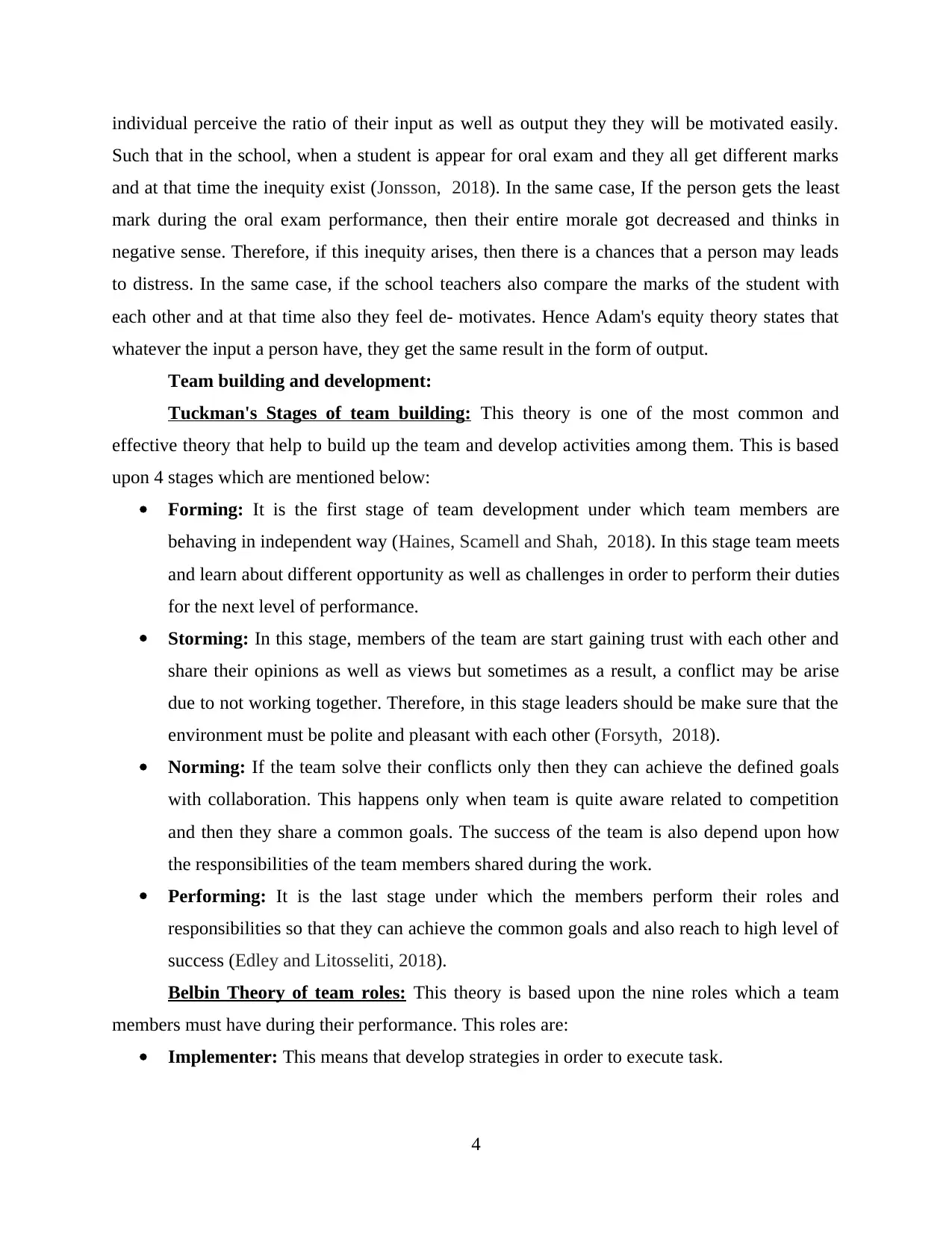
individual perceive the ratio of their input as well as output they they will be motivated easily.
Such that in the school, when a student is appear for oral exam and they all get different marks
and at that time the inequity exist (Jonsson, 2018). In the same case, If the person gets the least
mark during the oral exam performance, then their entire morale got decreased and thinks in
negative sense. Therefore, if this inequity arises, then there is a chances that a person may leads
to distress. In the same case, if the school teachers also compare the marks of the student with
each other and at that time also they feel de- motivates. Hence Adam's equity theory states that
whatever the input a person have, they get the same result in the form of output.
Team building and development:
Tuckman's Stages of team building: This theory is one of the most common and
effective theory that help to build up the team and develop activities among them. This is based
upon 4 stages which are mentioned below:
Forming: It is the first stage of team development under which team members are
behaving in independent way (Haines, Scamell and Shah, 2018). In this stage team meets
and learn about different opportunity as well as challenges in order to perform their duties
for the next level of performance.
Storming: In this stage, members of the team are start gaining trust with each other and
share their opinions as well as views but sometimes as a result, a conflict may be arise
due to not working together. Therefore, in this stage leaders should be make sure that the
environment must be polite and pleasant with each other (Forsyth, 2018).
Norming: If the team solve their conflicts only then they can achieve the defined goals
with collaboration. This happens only when team is quite aware related to competition
and then they share a common goals. The success of the team is also depend upon how
the responsibilities of the team members shared during the work.
Performing: It is the last stage under which the members perform their roles and
responsibilities so that they can achieve the common goals and also reach to high level of
success (Edley and Litosseliti, 2018).
Belbin Theory of team roles: This theory is based upon the nine roles which a team
members must have during their performance. This roles are:
Implementer: This means that develop strategies in order to execute task.
4
Such that in the school, when a student is appear for oral exam and they all get different marks
and at that time the inequity exist (Jonsson, 2018). In the same case, If the person gets the least
mark during the oral exam performance, then their entire morale got decreased and thinks in
negative sense. Therefore, if this inequity arises, then there is a chances that a person may leads
to distress. In the same case, if the school teachers also compare the marks of the student with
each other and at that time also they feel de- motivates. Hence Adam's equity theory states that
whatever the input a person have, they get the same result in the form of output.
Team building and development:
Tuckman's Stages of team building: This theory is one of the most common and
effective theory that help to build up the team and develop activities among them. This is based
upon 4 stages which are mentioned below:
Forming: It is the first stage of team development under which team members are
behaving in independent way (Haines, Scamell and Shah, 2018). In this stage team meets
and learn about different opportunity as well as challenges in order to perform their duties
for the next level of performance.
Storming: In this stage, members of the team are start gaining trust with each other and
share their opinions as well as views but sometimes as a result, a conflict may be arise
due to not working together. Therefore, in this stage leaders should be make sure that the
environment must be polite and pleasant with each other (Forsyth, 2018).
Norming: If the team solve their conflicts only then they can achieve the defined goals
with collaboration. This happens only when team is quite aware related to competition
and then they share a common goals. The success of the team is also depend upon how
the responsibilities of the team members shared during the work.
Performing: It is the last stage under which the members perform their roles and
responsibilities so that they can achieve the common goals and also reach to high level of
success (Edley and Litosseliti, 2018).
Belbin Theory of team roles: This theory is based upon the nine roles which a team
members must have during their performance. This roles are:
Implementer: This means that develop strategies in order to execute task.
4
⊘ This is a preview!⊘
Do you want full access?
Subscribe today to unlock all pages.

Trusted by 1+ million students worldwide
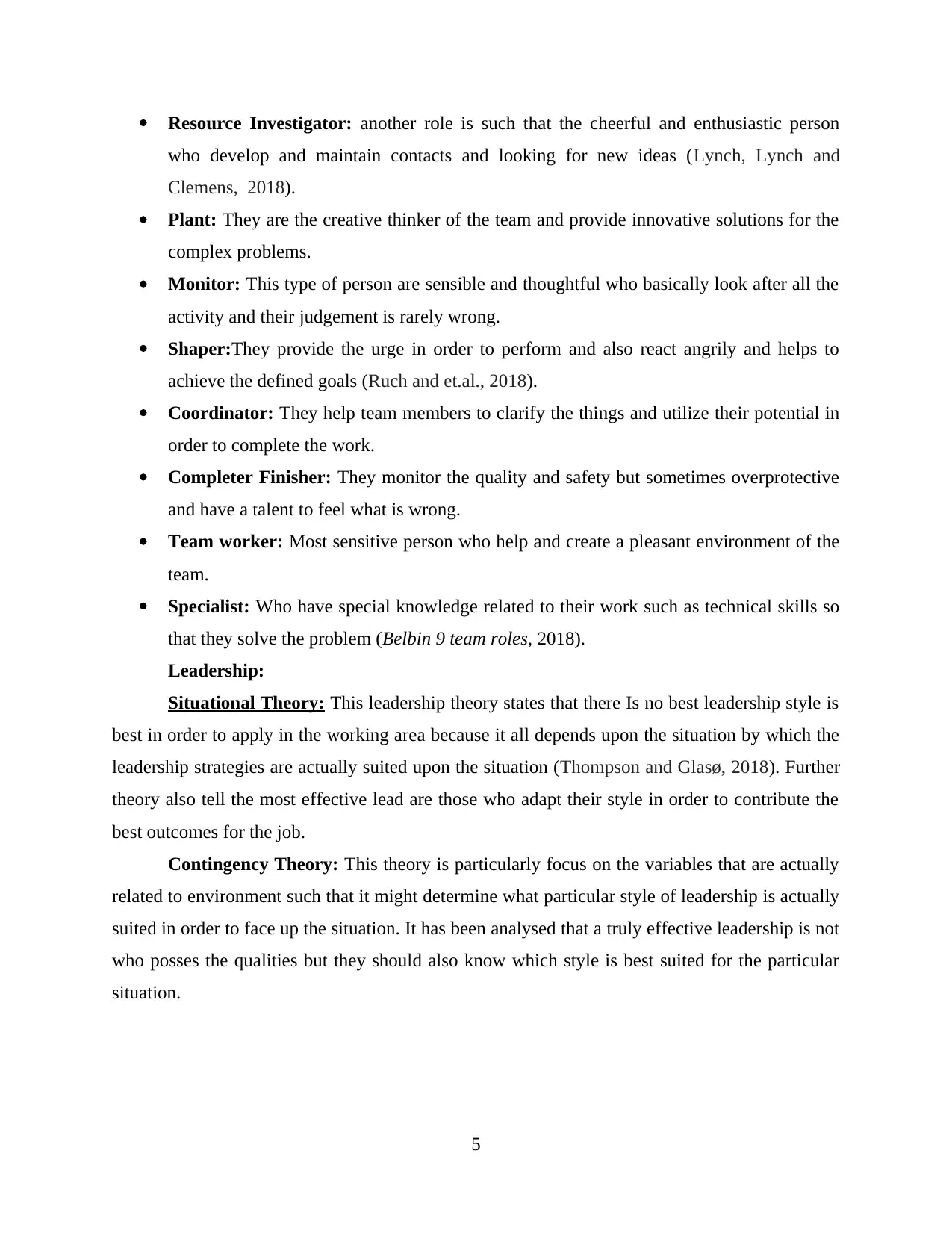
Resource Investigator: another role is such that the cheerful and enthusiastic person
who develop and maintain contacts and looking for new ideas (Lynch, Lynch and
Clemens, 2018).
Plant: They are the creative thinker of the team and provide innovative solutions for the
complex problems.
Monitor: This type of person are sensible and thoughtful who basically look after all the
activity and their judgement is rarely wrong.
Shaper:They provide the urge in order to perform and also react angrily and helps to
achieve the defined goals (Ruch and et.al., 2018).
Coordinator: They help team members to clarify the things and utilize their potential in
order to complete the work.
Completer Finisher: They monitor the quality and safety but sometimes overprotective
and have a talent to feel what is wrong.
Team worker: Most sensitive person who help and create a pleasant environment of the
team.
Specialist: Who have special knowledge related to their work such as technical skills so
that they solve the problem (Belbin 9 team roles, 2018).
Leadership:
Situational Theory: This leadership theory states that there Is no best leadership style is
best in order to apply in the working area because it all depends upon the situation by which the
leadership strategies are actually suited upon the situation (Thompson and Glasø, 2018). Further
theory also tell the most effective lead are those who adapt their style in order to contribute the
best outcomes for the job.
Contingency Theory: This theory is particularly focus on the variables that are actually
related to environment such that it might determine what particular style of leadership is actually
suited in order to face up the situation. It has been analysed that a truly effective leadership is not
who posses the qualities but they should also know which style is best suited for the particular
situation.
5
who develop and maintain contacts and looking for new ideas (Lynch, Lynch and
Clemens, 2018).
Plant: They are the creative thinker of the team and provide innovative solutions for the
complex problems.
Monitor: This type of person are sensible and thoughtful who basically look after all the
activity and their judgement is rarely wrong.
Shaper:They provide the urge in order to perform and also react angrily and helps to
achieve the defined goals (Ruch and et.al., 2018).
Coordinator: They help team members to clarify the things and utilize their potential in
order to complete the work.
Completer Finisher: They monitor the quality and safety but sometimes overprotective
and have a talent to feel what is wrong.
Team worker: Most sensitive person who help and create a pleasant environment of the
team.
Specialist: Who have special knowledge related to their work such as technical skills so
that they solve the problem (Belbin 9 team roles, 2018).
Leadership:
Situational Theory: This leadership theory states that there Is no best leadership style is
best in order to apply in the working area because it all depends upon the situation by which the
leadership strategies are actually suited upon the situation (Thompson and Glasø, 2018). Further
theory also tell the most effective lead are those who adapt their style in order to contribute the
best outcomes for the job.
Contingency Theory: This theory is particularly focus on the variables that are actually
related to environment such that it might determine what particular style of leadership is actually
suited in order to face up the situation. It has been analysed that a truly effective leadership is not
who posses the qualities but they should also know which style is best suited for the particular
situation.
5
Paraphrase This Document
Need a fresh take? Get an instant paraphrase of this document with our AI Paraphraser
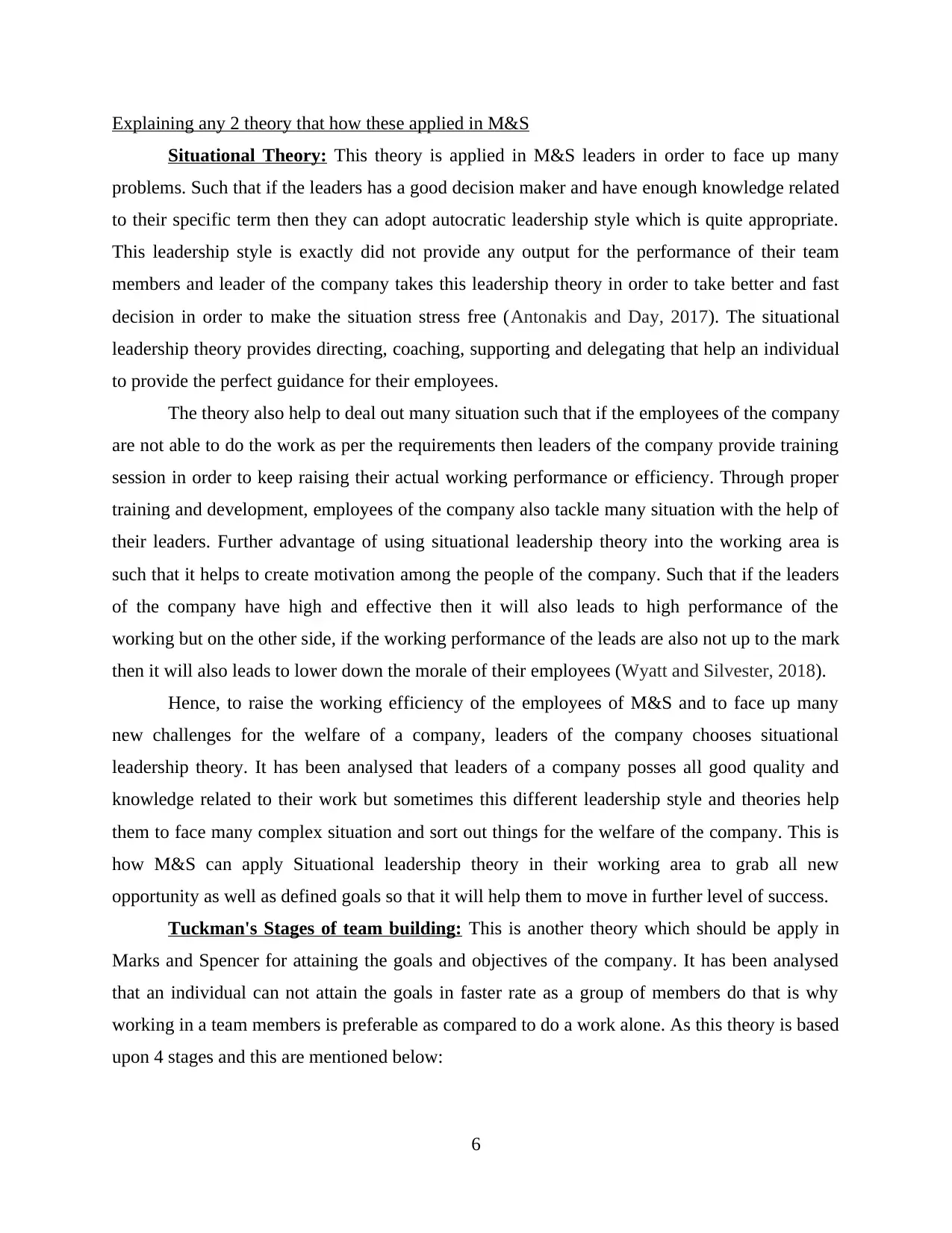
Explaining any 2 theory that how these applied in M&S
Situational Theory: This theory is applied in M&S leaders in order to face up many
problems. Such that if the leaders has a good decision maker and have enough knowledge related
to their specific term then they can adopt autocratic leadership style which is quite appropriate.
This leadership style is exactly did not provide any output for the performance of their team
members and leader of the company takes this leadership theory in order to take better and fast
decision in order to make the situation stress free (Antonakis and Day, 2017). The situational
leadership theory provides directing, coaching, supporting and delegating that help an individual
to provide the perfect guidance for their employees.
The theory also help to deal out many situation such that if the employees of the company
are not able to do the work as per the requirements then leaders of the company provide training
session in order to keep raising their actual working performance or efficiency. Through proper
training and development, employees of the company also tackle many situation with the help of
their leaders. Further advantage of using situational leadership theory into the working area is
such that it helps to create motivation among the people of the company. Such that if the leaders
of the company have high and effective then it will also leads to high performance of the
working but on the other side, if the working performance of the leads are also not up to the mark
then it will also leads to lower down the morale of their employees (Wyatt and Silvester, 2018).
Hence, to raise the working efficiency of the employees of M&S and to face up many
new challenges for the welfare of a company, leaders of the company chooses situational
leadership theory. It has been analysed that leaders of a company posses all good quality and
knowledge related to their work but sometimes this different leadership style and theories help
them to face many complex situation and sort out things for the welfare of the company. This is
how M&S can apply Situational leadership theory in their working area to grab all new
opportunity as well as defined goals so that it will help them to move in further level of success.
Tuckman's Stages of team building: This is another theory which should be apply in
Marks and Spencer for attaining the goals and objectives of the company. It has been analysed
that an individual can not attain the goals in faster rate as a group of members do that is why
working in a team members is preferable as compared to do a work alone. As this theory is based
upon 4 stages and this are mentioned below:
6
Situational Theory: This theory is applied in M&S leaders in order to face up many
problems. Such that if the leaders has a good decision maker and have enough knowledge related
to their specific term then they can adopt autocratic leadership style which is quite appropriate.
This leadership style is exactly did not provide any output for the performance of their team
members and leader of the company takes this leadership theory in order to take better and fast
decision in order to make the situation stress free (Antonakis and Day, 2017). The situational
leadership theory provides directing, coaching, supporting and delegating that help an individual
to provide the perfect guidance for their employees.
The theory also help to deal out many situation such that if the employees of the company
are not able to do the work as per the requirements then leaders of the company provide training
session in order to keep raising their actual working performance or efficiency. Through proper
training and development, employees of the company also tackle many situation with the help of
their leaders. Further advantage of using situational leadership theory into the working area is
such that it helps to create motivation among the people of the company. Such that if the leaders
of the company have high and effective then it will also leads to high performance of the
working but on the other side, if the working performance of the leads are also not up to the mark
then it will also leads to lower down the morale of their employees (Wyatt and Silvester, 2018).
Hence, to raise the working efficiency of the employees of M&S and to face up many
new challenges for the welfare of a company, leaders of the company chooses situational
leadership theory. It has been analysed that leaders of a company posses all good quality and
knowledge related to their work but sometimes this different leadership style and theories help
them to face many complex situation and sort out things for the welfare of the company. This is
how M&S can apply Situational leadership theory in their working area to grab all new
opportunity as well as defined goals so that it will help them to move in further level of success.
Tuckman's Stages of team building: This is another theory which should be apply in
Marks and Spencer for attaining the goals and objectives of the company. It has been analysed
that an individual can not attain the goals in faster rate as a group of members do that is why
working in a team members is preferable as compared to do a work alone. As this theory is based
upon 4 stages and this are mentioned below:
6
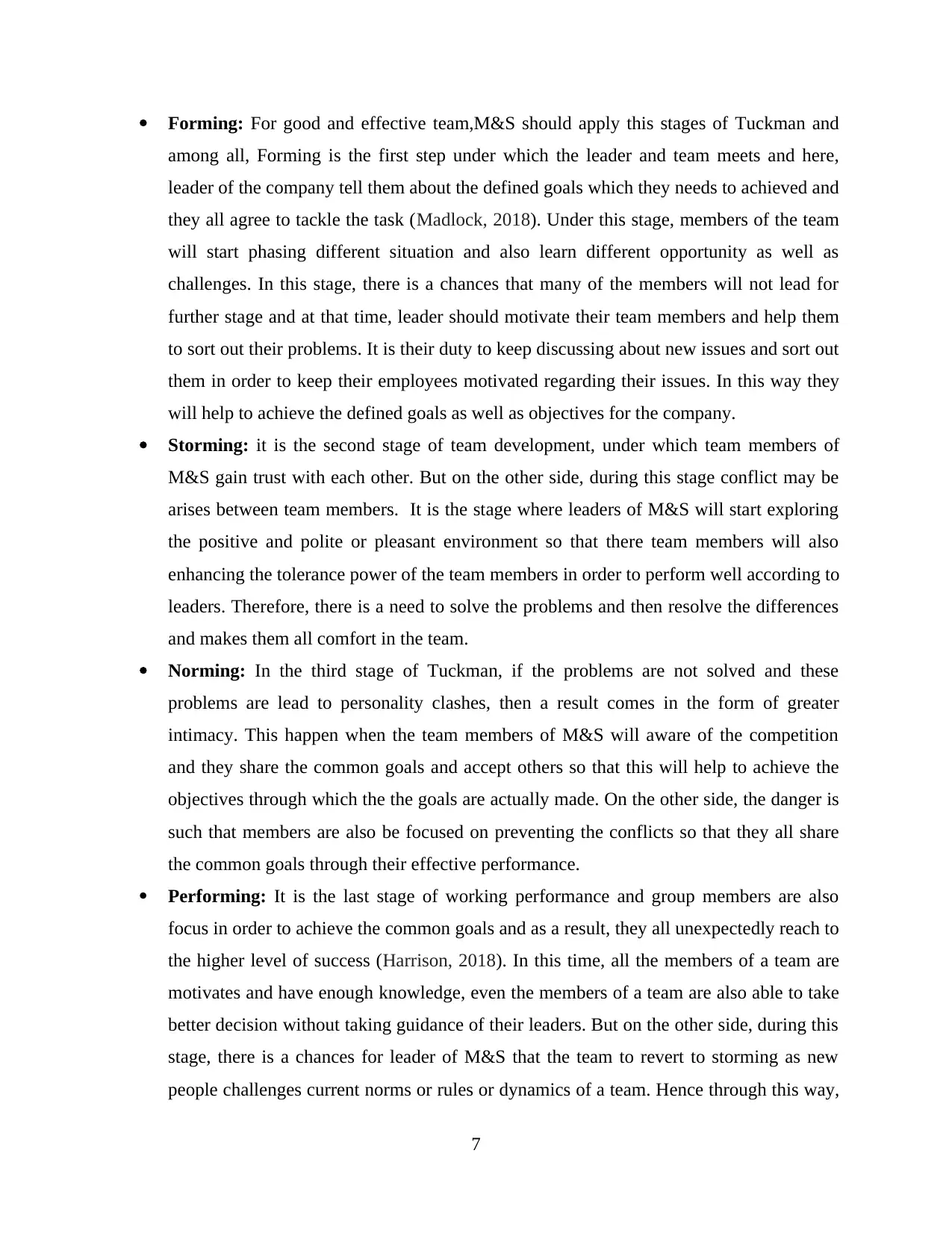
Forming: For good and effective team,M&S should apply this stages of Tuckman and
among all, Forming is the first step under which the leader and team meets and here,
leader of the company tell them about the defined goals which they needs to achieved and
they all agree to tackle the task (Madlock, 2018). Under this stage, members of the team
will start phasing different situation and also learn different opportunity as well as
challenges. In this stage, there is a chances that many of the members will not lead for
further stage and at that time, leader should motivate their team members and help them
to sort out their problems. It is their duty to keep discussing about new issues and sort out
them in order to keep their employees motivated regarding their issues. In this way they
will help to achieve the defined goals as well as objectives for the company.
Storming: it is the second stage of team development, under which team members of
M&S gain trust with each other. But on the other side, during this stage conflict may be
arises between team members. It is the stage where leaders of M&S will start exploring
the positive and polite or pleasant environment so that there team members will also
enhancing the tolerance power of the team members in order to perform well according to
leaders. Therefore, there is a need to solve the problems and then resolve the differences
and makes them all comfort in the team.
Norming: In the third stage of Tuckman, if the problems are not solved and these
problems are lead to personality clashes, then a result comes in the form of greater
intimacy. This happen when the team members of M&S will aware of the competition
and they share the common goals and accept others so that this will help to achieve the
objectives through which the the goals are actually made. On the other side, the danger is
such that members are also be focused on preventing the conflicts so that they all share
the common goals through their effective performance.
Performing: It is the last stage of working performance and group members are also
focus in order to achieve the common goals and as a result, they all unexpectedly reach to
the higher level of success (Harrison, 2018). In this time, all the members of a team are
motivates and have enough knowledge, even the members of a team are also able to take
better decision without taking guidance of their leaders. But on the other side, during this
stage, there is a chances for leader of M&S that the team to revert to storming as new
people challenges current norms or rules or dynamics of a team. Hence through this way,
7
among all, Forming is the first step under which the leader and team meets and here,
leader of the company tell them about the defined goals which they needs to achieved and
they all agree to tackle the task (Madlock, 2018). Under this stage, members of the team
will start phasing different situation and also learn different opportunity as well as
challenges. In this stage, there is a chances that many of the members will not lead for
further stage and at that time, leader should motivate their team members and help them
to sort out their problems. It is their duty to keep discussing about new issues and sort out
them in order to keep their employees motivated regarding their issues. In this way they
will help to achieve the defined goals as well as objectives for the company.
Storming: it is the second stage of team development, under which team members of
M&S gain trust with each other. But on the other side, during this stage conflict may be
arises between team members. It is the stage where leaders of M&S will start exploring
the positive and polite or pleasant environment so that there team members will also
enhancing the tolerance power of the team members in order to perform well according to
leaders. Therefore, there is a need to solve the problems and then resolve the differences
and makes them all comfort in the team.
Norming: In the third stage of Tuckman, if the problems are not solved and these
problems are lead to personality clashes, then a result comes in the form of greater
intimacy. This happen when the team members of M&S will aware of the competition
and they share the common goals and accept others so that this will help to achieve the
objectives through which the the goals are actually made. On the other side, the danger is
such that members are also be focused on preventing the conflicts so that they all share
the common goals through their effective performance.
Performing: It is the last stage of working performance and group members are also
focus in order to achieve the common goals and as a result, they all unexpectedly reach to
the higher level of success (Harrison, 2018). In this time, all the members of a team are
motivates and have enough knowledge, even the members of a team are also able to take
better decision without taking guidance of their leaders. But on the other side, during this
stage, there is a chances for leader of M&S that the team to revert to storming as new
people challenges current norms or rules or dynamics of a team. Hence through this way,
7
⊘ This is a preview!⊘
Do you want full access?
Subscribe today to unlock all pages.

Trusted by 1+ million students worldwide
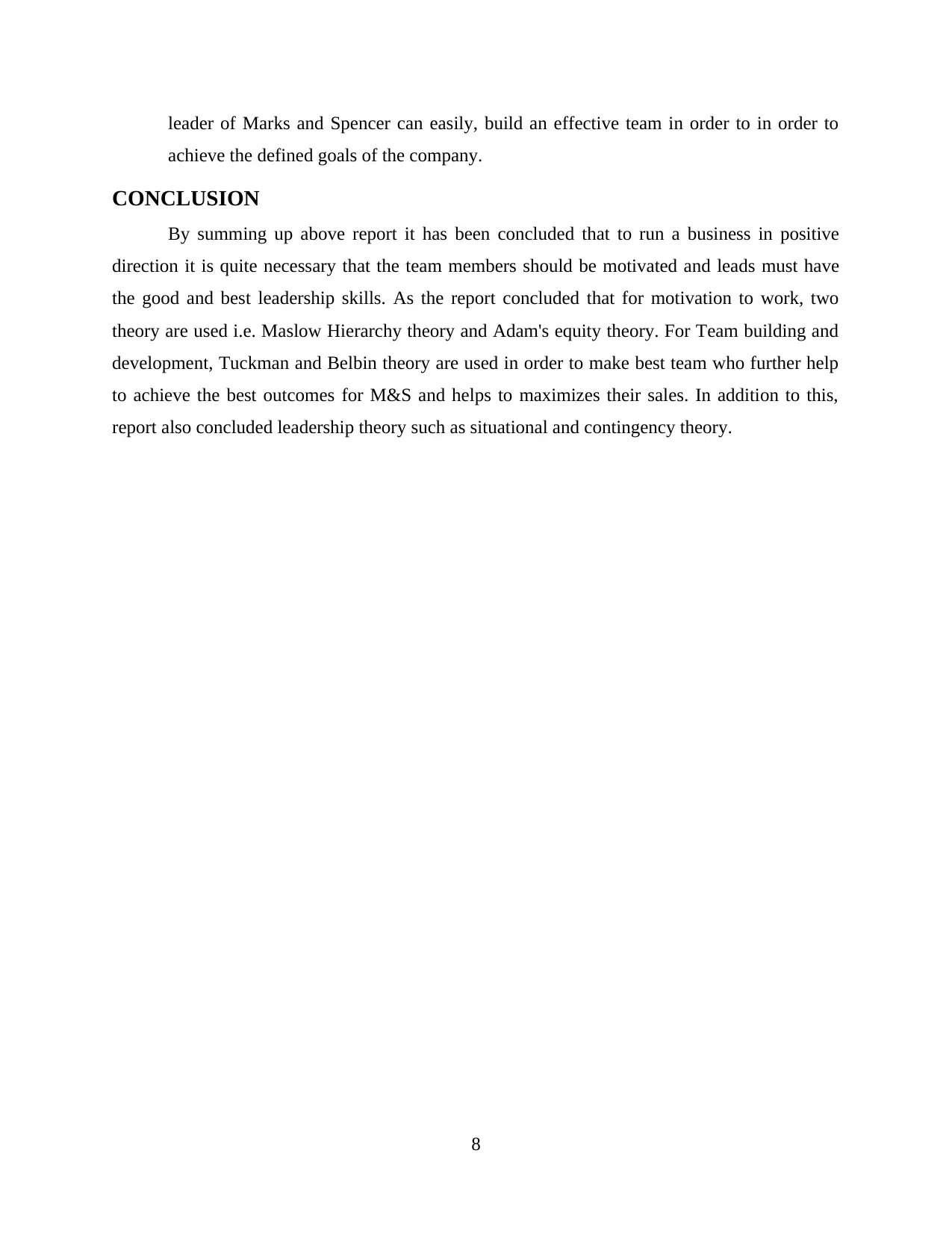
leader of Marks and Spencer can easily, build an effective team in order to in order to
achieve the defined goals of the company.
CONCLUSION
By summing up above report it has been concluded that to run a business in positive
direction it is quite necessary that the team members should be motivated and leads must have
the good and best leadership skills. As the report concluded that for motivation to work, two
theory are used i.e. Maslow Hierarchy theory and Adam's equity theory. For Team building and
development, Tuckman and Belbin theory are used in order to make best team who further help
to achieve the best outcomes for M&S and helps to maximizes their sales. In addition to this,
report also concluded leadership theory such as situational and contingency theory.
8
achieve the defined goals of the company.
CONCLUSION
By summing up above report it has been concluded that to run a business in positive
direction it is quite necessary that the team members should be motivated and leads must have
the good and best leadership skills. As the report concluded that for motivation to work, two
theory are used i.e. Maslow Hierarchy theory and Adam's equity theory. For Team building and
development, Tuckman and Belbin theory are used in order to make best team who further help
to achieve the best outcomes for M&S and helps to maximizes their sales. In addition to this,
report also concluded leadership theory such as situational and contingency theory.
8
Paraphrase This Document
Need a fresh take? Get an instant paraphrase of this document with our AI Paraphraser
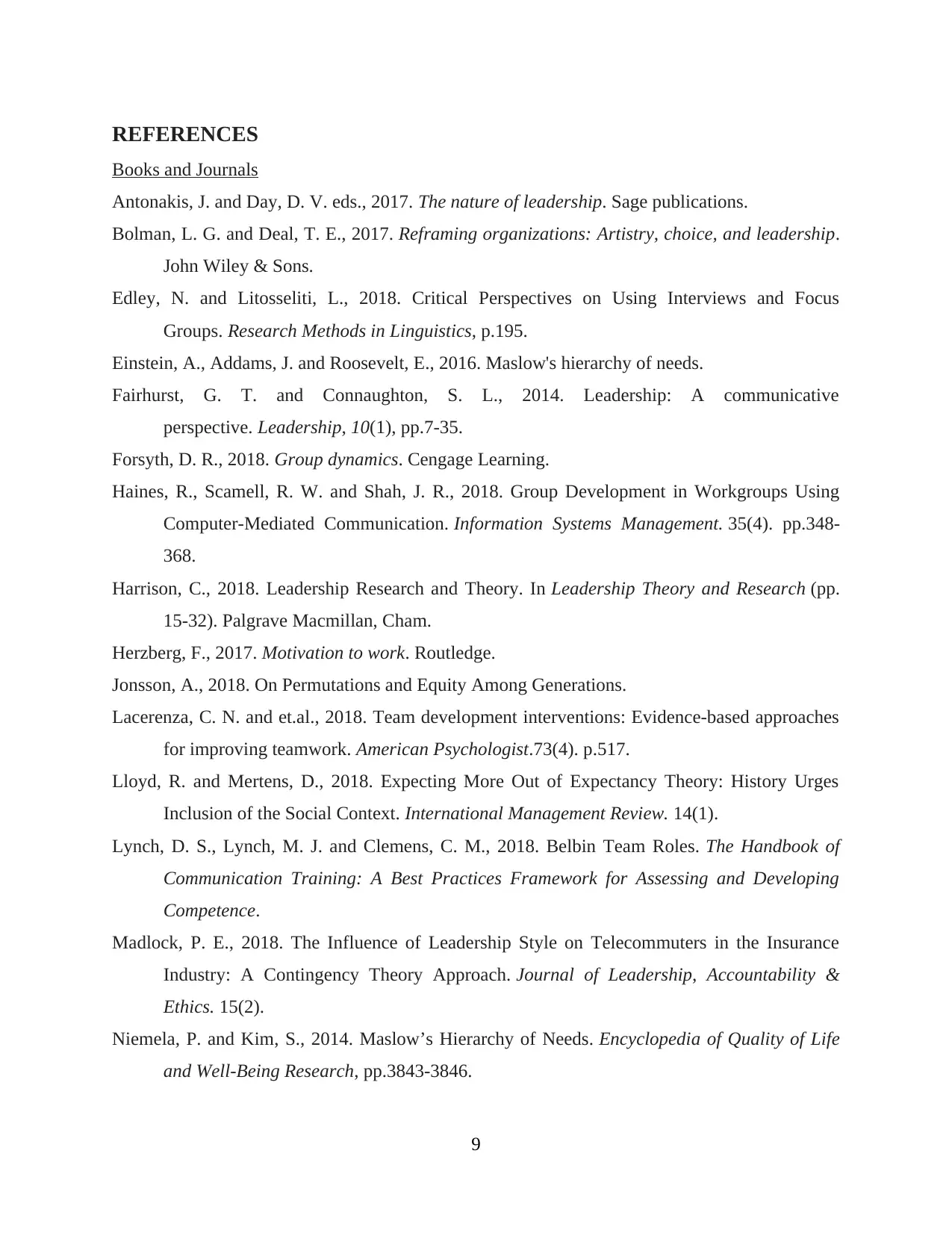
REFERENCES
Books and Journals
Antonakis, J. and Day, D. V. eds., 2017. The nature of leadership. Sage publications.
Bolman, L. G. and Deal, T. E., 2017. Reframing organizations: Artistry, choice, and leadership.
John Wiley & Sons.
Edley, N. and Litosseliti, L., 2018. Critical Perspectives on Using Interviews and Focus
Groups. Research Methods in Linguistics, p.195.
Einstein, A., Addams, J. and Roosevelt, E., 2016. Maslow's hierarchy of needs.
Fairhurst, G. T. and Connaughton, S. L., 2014. Leadership: A communicative
perspective. Leadership, 10(1), pp.7-35.
Forsyth, D. R., 2018. Group dynamics. Cengage Learning.
Haines, R., Scamell, R. W. and Shah, J. R., 2018. Group Development in Workgroups Using
Computer-Mediated Communication. Information Systems Management. 35(4). pp.348-
368.
Harrison, C., 2018. Leadership Research and Theory. In Leadership Theory and Research (pp.
15-32). Palgrave Macmillan, Cham.
Herzberg, F., 2017. Motivation to work. Routledge.
Jonsson, A., 2018. On Permutations and Equity Among Generations.
Lacerenza, C. N. and et.al., 2018. Team development interventions: Evidence-based approaches
for improving teamwork. American Psychologist.73(4). p.517.
Lloyd, R. and Mertens, D., 2018. Expecting More Out of Expectancy Theory: History Urges
Inclusion of the Social Context. International Management Review. 14(1).
Lynch, D. S., Lynch, M. J. and Clemens, C. M., 2018. Belbin Team Roles. The Handbook of
Communication Training: A Best Practices Framework for Assessing and Developing
Competence.
Madlock, P. E., 2018. The Influence of Leadership Style on Telecommuters in the Insurance
Industry: A Contingency Theory Approach. Journal of Leadership, Accountability &
Ethics. 15(2).
Niemela, P. and Kim, S., 2014. Maslow’s Hierarchy of Needs. Encyclopedia of Quality of Life
and Well-Being Research, pp.3843-3846.
9
Books and Journals
Antonakis, J. and Day, D. V. eds., 2017. The nature of leadership. Sage publications.
Bolman, L. G. and Deal, T. E., 2017. Reframing organizations: Artistry, choice, and leadership.
John Wiley & Sons.
Edley, N. and Litosseliti, L., 2018. Critical Perspectives on Using Interviews and Focus
Groups. Research Methods in Linguistics, p.195.
Einstein, A., Addams, J. and Roosevelt, E., 2016. Maslow's hierarchy of needs.
Fairhurst, G. T. and Connaughton, S. L., 2014. Leadership: A communicative
perspective. Leadership, 10(1), pp.7-35.
Forsyth, D. R., 2018. Group dynamics. Cengage Learning.
Haines, R., Scamell, R. W. and Shah, J. R., 2018. Group Development in Workgroups Using
Computer-Mediated Communication. Information Systems Management. 35(4). pp.348-
368.
Harrison, C., 2018. Leadership Research and Theory. In Leadership Theory and Research (pp.
15-32). Palgrave Macmillan, Cham.
Herzberg, F., 2017. Motivation to work. Routledge.
Jonsson, A., 2018. On Permutations and Equity Among Generations.
Lacerenza, C. N. and et.al., 2018. Team development interventions: Evidence-based approaches
for improving teamwork. American Psychologist.73(4). p.517.
Lloyd, R. and Mertens, D., 2018. Expecting More Out of Expectancy Theory: History Urges
Inclusion of the Social Context. International Management Review. 14(1).
Lynch, D. S., Lynch, M. J. and Clemens, C. M., 2018. Belbin Team Roles. The Handbook of
Communication Training: A Best Practices Framework for Assessing and Developing
Competence.
Madlock, P. E., 2018. The Influence of Leadership Style on Telecommuters in the Insurance
Industry: A Contingency Theory Approach. Journal of Leadership, Accountability &
Ethics. 15(2).
Niemela, P. and Kim, S., 2014. Maslow’s Hierarchy of Needs. Encyclopedia of Quality of Life
and Well-Being Research, pp.3843-3846.
9
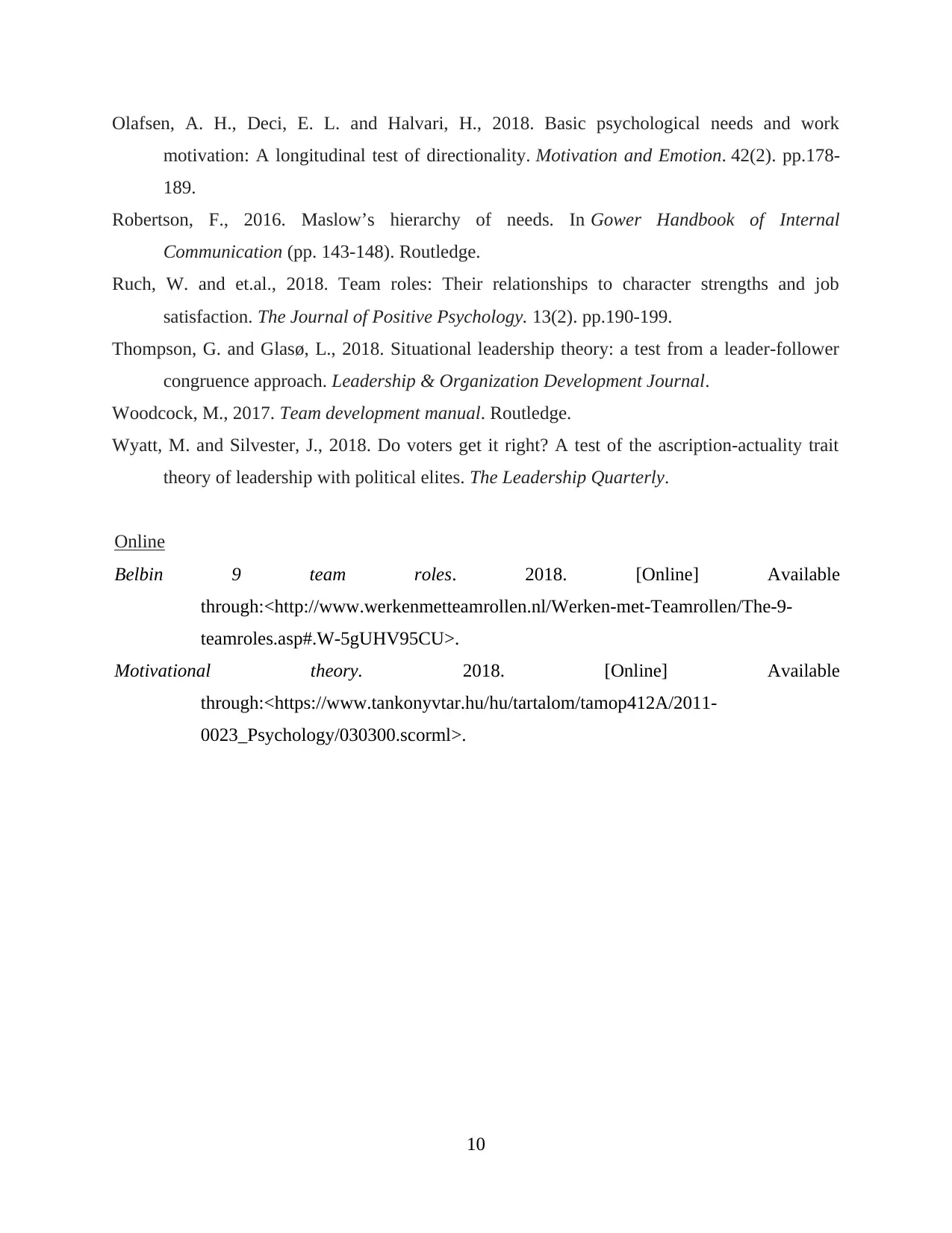
Olafsen, A. H., Deci, E. L. and Halvari, H., 2018. Basic psychological needs and work
motivation: A longitudinal test of directionality. Motivation and Emotion. 42(2). pp.178-
189.
Robertson, F., 2016. Maslow’s hierarchy of needs. In Gower Handbook of Internal
Communication (pp. 143-148). Routledge.
Ruch, W. and et.al., 2018. Team roles: Their relationships to character strengths and job
satisfaction. The Journal of Positive Psychology. 13(2). pp.190-199.
Thompson, G. and Glasø, L., 2018. Situational leadership theory: a test from a leader-follower
congruence approach. Leadership & Organization Development Journal.
Woodcock, M., 2017. Team development manual. Routledge.
Wyatt, M. and Silvester, J., 2018. Do voters get it right? A test of the ascription-actuality trait
theory of leadership with political elites. The Leadership Quarterly.
Online
Belbin 9 team roles. 2018. [Online] Available
through:<http://www.werkenmetteamrollen.nl/Werken-met-Teamrollen/The-9-
teamroles.asp#.W-5gUHV95CU>.
Motivational theory. 2018. [Online] Available
through:<https://www.tankonyvtar.hu/hu/tartalom/tamop412A/2011-
0023_Psychology/030300.scorml>.
10
motivation: A longitudinal test of directionality. Motivation and Emotion. 42(2). pp.178-
189.
Robertson, F., 2016. Maslow’s hierarchy of needs. In Gower Handbook of Internal
Communication (pp. 143-148). Routledge.
Ruch, W. and et.al., 2018. Team roles: Their relationships to character strengths and job
satisfaction. The Journal of Positive Psychology. 13(2). pp.190-199.
Thompson, G. and Glasø, L., 2018. Situational leadership theory: a test from a leader-follower
congruence approach. Leadership & Organization Development Journal.
Woodcock, M., 2017. Team development manual. Routledge.
Wyatt, M. and Silvester, J., 2018. Do voters get it right? A test of the ascription-actuality trait
theory of leadership with political elites. The Leadership Quarterly.
Online
Belbin 9 team roles. 2018. [Online] Available
through:<http://www.werkenmetteamrollen.nl/Werken-met-Teamrollen/The-9-
teamroles.asp#.W-5gUHV95CU>.
Motivational theory. 2018. [Online] Available
through:<https://www.tankonyvtar.hu/hu/tartalom/tamop412A/2011-
0023_Psychology/030300.scorml>.
10
⊘ This is a preview!⊘
Do you want full access?
Subscribe today to unlock all pages.

Trusted by 1+ million students worldwide
1 out of 12
Related Documents
Your All-in-One AI-Powered Toolkit for Academic Success.
+13062052269
info@desklib.com
Available 24*7 on WhatsApp / Email
![[object Object]](/_next/static/media/star-bottom.7253800d.svg)
Unlock your academic potential
Copyright © 2020–2025 A2Z Services. All Rights Reserved. Developed and managed by ZUCOL.




